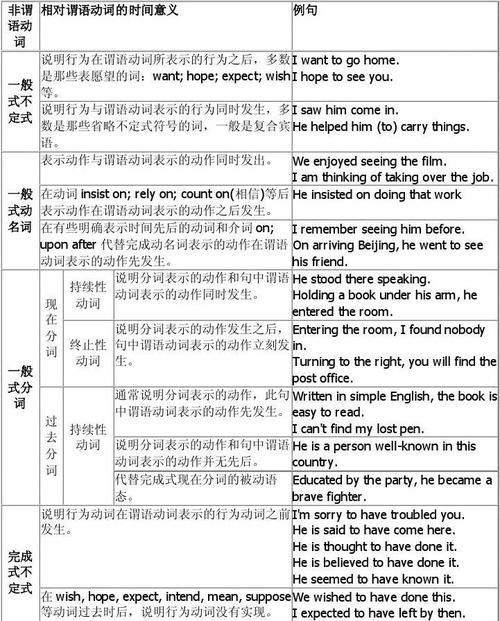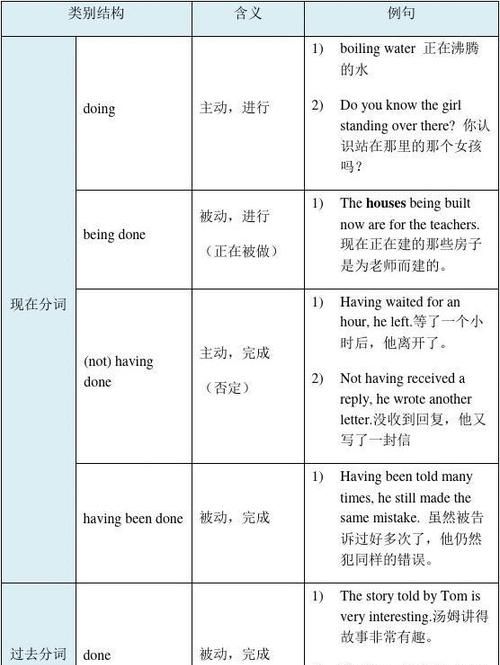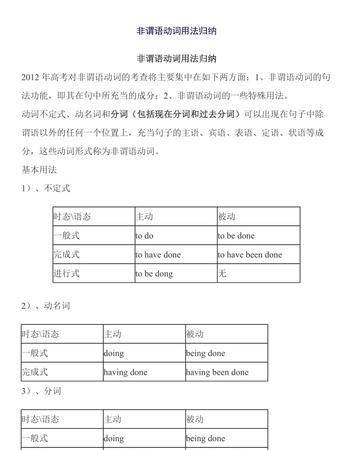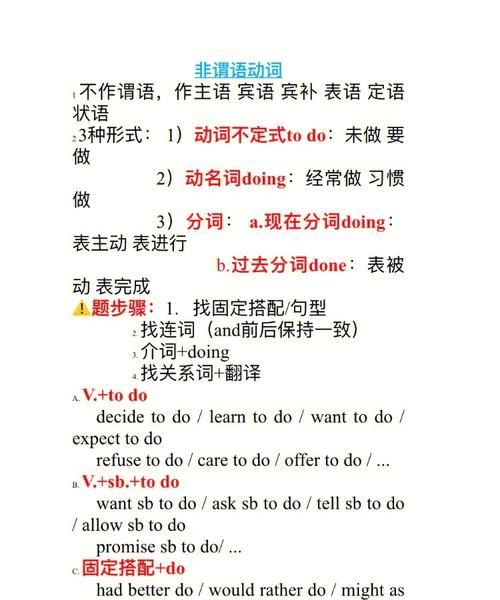本文目录
英语非谓语动词用法详解
非谓语动词
在句子中充当除谓语以外的句子成分的动词形式叫做非谓语动词
是动词的非谓语形式.动词一般在句子中充当谓语.在句中可起名词,形容词,副词的作用,在句中充当主语,宾语,表语,补语,定语或状语.即动词的非谓语形式除了不能独立作谓语外,可以承担句子的任何成分
3种形式:不定式,分词(现在分词、过去分词),动名词
1.非谓语动词与谓语动词的相同点有:
(1)如果是及物动词都可与宾语连用,例如:
They built a garden.
They suggested building a garden.
(2)都可以被状语修饰:
The suit fits him very well.
The suit used to fit him very well.
(3)都有主动与被动, “体”式(一般式;进行式;完成式)的变化。例如:
He was punished by his parents.(谓语动词被动语态)
He avoided being punished by his parents.(动名词的被动式)
We have written the composition.(谓语动词的完成时)
Having written the composition, we handed it in.(现在分词的完成式)
(4)都可以有逻辑主语
They started the work at once.(谓语动词的逻辑主语)
The boss ordered them to start the work.(动词不定式的逻辑主语)
We are League members.(谓语动词的主语)
We being League member, the work was well done.
(现在分词的逻辑主语)
2、非谓语动词与谓语动词的不同点有:
(1)非谓语动词可以有名词作用(如动词不定式和动名词),在句中做主语、宾语、表语。
(2)非谓语动词可以有形容词作用(如动词不定式和分词),在句中做定语、表语或宾语补足语。
(3)非谓语动词可以有副词作用(如动词不定式和分词),在句中作状语。
(4)谓语动词在句中作谓语,受主语的人称和数的限制;非谓语动词在句中不能单独作谓语,它不受主语的人称和数的限制。
(二)非谓语动词的句法功能:
二、非谓语动词用法:
(一)动词不定式:(to)+do,具有名词、形容词、副词的特征。
1.不定式的形式:(以动词write为例)
否定式:not + (to) do
(1)一般式:不定式的一般式所表示的动作与谓语动词动作同时发生或发生在谓语动词动作之后,
例如:
I'm glad to meet you.
He seems to know a lot.
We plan to pay a visit.
He wants to be an artist.
The patient asked to be operated on at once.
The teacher ordered the work to be done.
(2)进行式:不定式的进行式所表示的动作与谓语动词动作同时发生,例如:
The boy pretended to be working hard.
He seems to be reading in his room.
(3)完成式:不定式的完成式表示的动作发生在谓语动词动作之前,例如:
I regretted to have told a lie.
I happened to have seen the film.
He is pleased to have met his friend.
2.不定式的句法功能:
(1)作主语:
To finish the work in ten minutes is very hard.
To lose your heart means failure.
动词不定式短语作主语时,常用it作形式主语,真正的主语不定式置于句后,例如上面两句可用如下形式:
It is very hard to finish the work in ten minutes.
It means failure to lose your heart.
常用句式有:1、It+be+名词+to do。2、It takes sb.+some time+to do。3、It+be+形容词+of sb +to do。4、It+be+形容词+for sb.+to do。常用careless,,clever,good,foolish,honest,kind,lazy,nice,right,silly,stupid,wise,等表示赞扬或批评的形容词,不定式前的sb.可作其逻辑主语。
(2)作表语:
Her job is to clean the hall.
He appears to have caught a cold.
(3)作宾语:
常与不定式做宾语连用的动词有:want, hope, wish, offer, fail, plan, learn, pretend, refuse, manage, help, agree, promise, prefer, 如果不定式(宾语)后面有宾语补足语,则用it作形式宾语,真正的宾语(不定式)后置,放在宾语补足语后面,例如:
Marx found it important to study the situation in Russia.
动词不定式也可充当介词宾语,如:
I have no choice but to stay here.
He did nothing last Sunday but repair his bike.
动词不定式前有时可与疑问词连用,如:
He gave us some advice on how to learn English.
(4)作宾语补足语:
在复合宾语中,动词不定式可充当宾语补足语,如下动词常跟这种复合宾语:want, wish, ask, tell, order, beg, permit, help, advise, persuade, allow, prepare, cause, force, call on, wait for, invite.
此外,介词有时也与这种复合宾语连用,如:
With a lot of work to do, he didn't go to the cinema.
有些动词如make, let, see, watch, hear, feel, have等与不带有to的不定式连用,但改为被动语态时,不定式要加to, 如:
I saw him cross the road.
He was seen to cross the road.
(5)作定语:
动词不定式作定语,放在所修饰的名词或代词后。与所修饰名词有如下关系:
①动宾关系:
I have a meeting to attend.
注意:不定式为不及物动词时,所修饰的名词如果是地点、工具等,应有必要的介词,如:
He found a good house to live in.
The child has nothing to worry about.
What did you open it with?
如果不定式修饰time, place, way,可以省略介词:
He has no place to live.
This is the best way to work out this problem.
如果不定式所修饰名词是不定式动作承受者,不定式可用主动式也可用被动式:
Have you got anything to send?
Have you got anything to be sent?
②说明所修饰名词的内容:
We have made a plan to finish the work.
③被修饰名词是不定式逻辑主语:
He is the first to get here.
(6)作状语:
①表目的:
He worked day and night to get the money.
She sold her hair to buy the watch chain.
注意不定式放句首时,逻辑主语与句子主语要一致:
wrong:To save money, every means has been tried.
right:To save money, he has tried every means.
wrong:To learn English well, a dictionary is needed.
right:To learn English well, he needs a dictionary.
②表结果:
He arrived late to find the train gone.
常用only放在不定式前表示强调:
I visited him only to find him out.
③表原因:
They were very sad to hear the news.
④表程度:
It's too dark for us to see anything.
The question is simple for him to answer.
(7)作独立成分:
To tell you the truth, I don't like the way he talked.
(8)不定式的省略:保留to省略do动词。
If you don't want to do it, you don't need to.
(9)不定式的并列:第二个不定式可省略to。
He wished to study medicine and become a doctor.
(二)动名词:
动名词既具有动词的一些特征,又具有名词的句法功能。
1.动名词的形式:
否定式:not + 动名词
(1)一般式:
Seeing is believing. 眼见为实。
(2)被动式:
He came to the party without being invited.他未被邀请就来到了晚会。
(3)完成式:
We remembered having seen the film. 我们记得看过这部电影。
(4)完成被动式:
He forgot having been taken to Guangzhou when he was five years old.
他忘记五岁时曾被带到广州去过。
(5)否定式:not + 动名词
I regret not following his advice. 我后悔没听他的劝告。
(6)复合结构:物主代词(或名词所有格)+ 动名词
He suggested our trying it once again. 他建议我们再试一次。
His not knowing English troubled him a lot.
他不懂英语给他带来许多麻烦。
2.动名词的句法功能:
(1)作主语:
Reading aloud is very helpful. 朗读是很有好处的。
Collecting stamps is interesting. 集邮很有趣。
当动名词短语作主语时常用it作形式主语。
It's no use quarrelling.争吵是没用的。
(2)作表语:
In the ant city, the queen's job is laying eggs.
在蚂蚁王国,蚁后的工作是产卵。
(3)作宾语:
They haven't finished building the dam. 他们还没有建好大坝。
We have to prevent the air from being polluted.
我们必须阻止空气被污染。
注意动名词既可作动词宾语也可作介词宾语,如上面两个例句。此外,动名词作宾语时,若跟有宾语补足语,则常用形式宾语it,例如:
We found it no good making fun of others. 我们发现取笑他人不好。
要记住如下动词及短语只跟动名词作宾语:
enjoy, finish, suggest, avoid(避免), excuse ,delay, imagine, keep, miss, consider, admit(承认),deny(否认), mind, permit, forbid, practise, risk(冒险), appreciate(感激), be busy, be worth, feel like, can't stand, can't help(情不自禁地), think of, dream of, be fond of, prevent…(from),keep …from, stop…(from),protect…from, set about, be engaged in, spend…(in), succeed in, be used to, look forward to, object to, pay attention to, insist on, feel like
(4)作定语:
He can't walk without a walking-stick. 他没有拐杖不能走路。
Is there a swimming pool in your school? 你们学校有游泳池吗?
(5)作同位语:
The cave, his hiding-place is secret. 那个山洞,他藏身的地方很秘密。
His habit, listening to the news on the radio remains unchanged.
他收听收音机新闻节目的习惯仍未改变。
(三)现在分词:
现在分词既具有动词的一些特征,又具有形容词和副词的句法功能。
1、现在分词的形式:
否定式:not + 现在分词
(1)现在分词的主动语态:现在分词主动语态的一般式表示与谓语动词所表示的动作同时发生,完成
式表示的动作在谓语动词所表示的动作之前发生,常作状语。例如:
They went to the park, singing and talking. 他们边唱边说向公园走去。
Having done his homework, he played basket-ball. 做完作业,他开始打篮球。
(2)现在分词的被动语态:一般式表示与谓语动词同时发生的被动的动作,完成式表示发生在谓语动
词之前的被动的动作。
The problem being discussed is very important. 正在被讨论的问题很重要。
Having been told many times, the naughty boy made the same mistake.
被告诉了好几遍,这个淘气的孩子又犯了同一个错误。
2.现在分词的句法功能:
(1)作定语:现在分词作定语,当分词单独做定语时,放在所修饰的名词前;如果是分词短语做定语
放在名词后。
In the following years he worked even harder.
在后来的几年中,他学习更努力了。
The man speaking to the teacher is our monitor's father.
正与老师谈话的那个人是我们班长的父亲。
现在分词作定语相当于一个定语从句的句法功能,如:in the following years也可用in the years that followed; the man speaking to the teacher可改为the man who is speaking to the teacher.
(2)现在分词作表语:
The film being shown in the cinema is exciting. 正在这家上演的电影很棒。
The present situation is inspiring. 当前的形势鼓舞人心。
be + doing既可能表示现在进行时,也可能是现在分词做表语,它们的区别在于be + doing表示进行的动作是进行时,而表示特征时是系动词be与现在分词构成系表结构。
(3)作宾语补足语:
如下动词后可跟现在分词作宾语补足语:
see, watch, hear, feel, find, get, keep, notice, observe, listen to, look at, leave, catch等。例如:
Can you hear her singing the song in the next room? 你能听见她在隔壁唱歌吗?
He kept the car waiting at the gate. 他让小汽车在门口等着。
(4)现在分词作状语:
①作时间状语:
(While) Working in the factory, he was an advanced worker.
在工厂工作时,他是一名先进工人。
②作原因状语:
Being a League member, he is always helping others. 由于是共青团员,他经常帮助他人。
③作方式状语,表示伴随:
He stayed at home, cleaning and washing. 他呆在家里,又擦又洗。
④作条件状语:
(If) Playing all day, you will waste your valuable time.
要是整天玩,你就会浪费宝贵的时间。
⑤作结果状语:
He dropped the glass, breaking it into pieces. 他把杯子掉了,结果摔得粉碎。
⑥作目的状语:
He went swimming the other day. 几天前他去游泳了。
⑦作让步状语:
Though raining heavily, it cleared up very soon.
虽然雨下得很大,但不久天就晴了。
⑧与逻辑主语构成独立主格:
I waiting for the bus, a bird fell on my head.
我等汽车时,一只鸟落到我头上。
All the tickets having been sold out, they went away disappointedly.
所有的票已经卖光了,他们失望地离开了。
Time permitting, we'll do another two exercises.
如果时间允许,我们将做另两个练习。
有时也可用with (without) +名词(代词宾格)+分词形式
With the lights burning, he fell asleep. 他点着灯睡着了。
⑨作独立成分:
udging from(by) his appearance, he must be an actor.
从外表看,他一定是个演员。
Generally speaking, girls are more careful. 一般说来,女孩子更细心。
(四)过去分词:
过去分词只有一种形式:规则动词由动词原形加词尾-ed构成。不规则动词的过去分词没有统一的规则要求,要一一记住。
过去分词的句法功能:
1.过去分词作定语:
Our class went on an organized trip last Monday. 上周一我们班开展了一次有组织的旅行。
Those elected as committee members will attend the meeting. 当选为委员的人将出席这次会。
注意当过去分词是单词时,一般用于名词前,如果是过去分词短语,就放在名词的后面。过去分词做定语相当于一个被动语态的定语从句。
2.过去分词作表语:
The window is broken. 窗户破了。
They were frightened at the sad sight. 他们对眼前悲惨的景象感到很害怕。
注意:be + 过去分词,如果表示状态是系表结构,如果表示被动的动作是被动语态。区别:
The window is broken.(系表)
The window was broken by the boy.(被动)
有些过去分词是不及物动词构成的,不表示被动,只表示完成。如:
boiled water(开水) fallen leaves(落叶)
newly arrived goods(新到的货) the risen sun(升起的太阳)
the changed world(变了的世界)
这类过去分词有:gone, come, fallen, risen, changed, arrived, returned, passed等。
3.过去分词作宾语补足语:
I heard the song sung several times last week.
上周我听见这首歌被唱了好几次。
有时过去分词做with短语中的宾语补足语:
With the work done, they went out to play. 工作做完了,他们出去玩去了。
4.过去分词作状语:
Praised by the neighbours, he became the pride of his parents.
受到邻居们的表扬,他成为父母的骄傲。(表示原因)
Once seen, it can never be forgotten.
一旦它被看见,人们就忘不了。(表示时间)
Given more time, I'll be able to do it better.
如果给予更多的时间,我能做得更好。(表示条件)
Though told of the danger, he still risked his life to save the boy.
虽然被告之有危险,他仍然冒生命危险去救那个孩子。(表示让步)
Filled with hopes and fears, he entered the cave. 心中充满了希望与恐惧,他走进山洞。

非谓语动词用法详解
非谓语动词和谓语动词的相对时间关系 非谓语动词
相对谓语动词的时间意义 例句
一般式不定式
说明行为在谓语动词所表示的行为之后,多数是那些表愿望的词:want; hope; expect; wish等。 I want to go home.
I hope to see you.
说明行为与谓语动词表示的行为同时发生,多数是那些省略不定式符号的词,一般是复合宾语。 I saw him come in.
He helped him (to) carry things.
一般式动名词
表示动作与谓语动词表示的动作同时发出。 We enjoyed seeing the film.
I am thinking of taking over the job.
在动词insist on; rely on; count on(相信)等后表示动作在谓语动词表示的动作之后发生。 He insisted on doing that work
在有些明确表示时间先后的动词和介词on; upon after代替完成动名词表示的动作在谓语动词表示的动作先发生。 I remember seeing him before.
On arriving Beijing, he went to see his friend.
一般式分词
现在分词
持续性动词
说明分词表示的动作和句中谓语动词表示的动作同时发生。 He stood there speaking.
Holding a book under his arm, he entered the room.
终止性动词
说明分词表示的动作发生之后,句中谓语动词表示的动作立刻发生。 Entering the room, I found nobody in.
Turning to the right, you will find the post office.
过去分词
持续性动词
通常说明分词表示的动作,此句中谓语动词表示的动作先发生。 Written in simple English, the book is easy to read.
I can't find my lost pen.
说明分词表示的动作和句中谓语动词表示的动作并无先后。 He is a person well-known in this country.
代替完成式现在分词的被动语态。 Educated by the party, he became a brave fighter.
完成式不定式
说明行为动词在谓语动词表示的行为动词之前发生。 I'm sorry to have troubled you.
He is said to have come here.
He is thought to have done it.
He is believed to have done it.
He seemed to have known it.
在wish, hope, expect, intend, mean, suppose等动词过去时后,说明行为动词没有实现。 We wished to have done this.
I expected to have left by then.
(=I had expected to heave by then.)
完成式动名词
说明动名词表示的动作,此句中动词表示的动作先发生。 We regret having told you the news.
After having finished his work, he went home.
He denied having broke the glasses.
完成式分词
说明分词表示的动作,此句中谓语动词表示的动作先发生。多数表示一些瞬时间动词。如果是hear; see或表示位置转移的动词arrive; leave; turn; open.不用完成时 Having finished his work, he went home.
Sitting down with him, we begun to discuss it.
Hearing this, he rose and went to the door.
非谓语动词用法对比
知识要点:
一、不定式与动名词做主语:
1、动名词做主语往往表示普通的、一般的行为,不定式做主语常表示某次具体的行为。例如:
Collecting information about children’s health is his job. 收集有关儿童健康的信息是他的工作。
It’s necessary to discuss the problem with an experienced teacher. 与一位有经验的老师讨论这个问题是有必要的。
2、常用不定式做主语的句型有:
(1)It’s difficult (important, necessary) for sb. to do
(2)It’s kind (good, friendly, polite, careless, rude, cruel, clever, foolish, brave) of sb. to do.
3、常用动名词做主语的句型有:
It’s no good (use, fun) doing.
It’s (a) waste of time one’s doing.
It’s worth while doing.
二、不定式、动名词、分词做表语:
1、不定式做表语常表示谓语动词所表示动作之后发生的动作。
His teaching aim of this class is to train the students’ speaking ability. 他这节课的教学目的是要训练学生说的能力。
2、动名词做表语是对主语内容的解释,这时主语与表语位置可以互换,动名词常用于口语中。
Its full-time job is laying eggs. 它的(指蚁后)的专职工作是产卵。
3、现在分词做表语表示主语的性质与特征;进行时表示正在进行的动作。
The task of this class is practising the idioms. (现在分词做表语)
With the help of the teacher, the students are practising the idioms. (现在进行时)
4、常用作表语的现在分词有:interesting, amusing, disappointing, missing, puzzling, exciting, inspiring, following等。现在分词表示进行与主动。
The joke is amusing .这笑话很逗人。
The problem is puzzling. 这个问题令人不解。
5、过去分词作表语表示主语所处的被动状态或完成某动作的状态。而被动语态表示主语所承受的动作。
The village is surrounded by high mountains.(过去分词做表语)
The enemy was surrounded by the Red Army.(被动语态)
He is well educated.(过去分词做表语)
He has been educated in this college for three years.(被动语态)
常用在句中做表语的过去分词有:
used, closed, covered, interested, followed, satisfied, surrounded, done, lost, decided, prepared, saved, shut, won, completed, crowded, dressed, wasted, broken, married, unexpected等。
6、注意如下动词的现在分词与过去分词用法不同:
interest(使…感兴趣),surprise(使…吃惊),frighten(使…害怕),excite(使…兴奋),tire(使…疲劳),please(使…满意),puzzle(使…迷惑不解),satisfy(使…满意),amuse(使…娱乐),disappoint(使…失望),inspire(使…欢欣鼓舞),worry(使…忧虑)
它们的现在分词常修饰物(有时修饰人),表示主动,过去分词常修饰人,表示被动(包括某人的look、voice等)。例如:
Climbing is tiring. 爬山很累人。
They are very tired. 他们很疲劳
After hearing the exciting news, he gave a speech in an excited voice.
三、不定式与动名词做宾语:
1、下列动词跟不定式做宾语:
want, wish, hope, expect, ask, pretend, care, decide, happen, long, offer, refuse, fail, plan, prepare, order, cause, afford, beg, manage, agree, promise等。
2、在下列动词或动词短语后用动名词做宾语:
enjoy, finish, suggest, avoid, excuse, delay, imagine, keep, miss, appreciate, be busy, be worth, feel like, can’t stand, can’t help, think of, dream of, be fond of, prevent…(from), keep…from, stop…(from), protect…from, set about, be engaged in, spend…(in), succeed in, be used to, look forward to, object to, pay attention to, insist on等。
3、在forget, remember, stop, regret, try, mean等动词后跟不定式与动名词意义不同,不定式表示谓语动词之后的动作,而动名词表示的动作发生在谓语动词之前,常用一般式doing代替完成式having done.
He forgot to tell me to post the letter.(他忘了叫我发信。)
I shall never forget finding that rare stamp on an ordinary envelope. 我永远也忘不了在一个普通信封上发现了那枚珍贵的邮票。
Remember to write to us when you get there. 到那里,记得给我们写信。
I don’t remember meeting him. 我不记得见过他。
I regret to tell you that I can’t go to your birth-day party. 我很遗憾告诉你我不能去参加你的生日晚会了。
They regretted agreeing to the plan. 他们后悔同意这个计划。
He tried to pretend to share in the pleasure with his friend. 他尽力假装与朋友分享欢乐。
She tried reading a novel, but that couldn’t make her forget her sorrow. 她试着看看小说,但也不能使她忘记伤心事。
I didn’t mean to hurt you. 我没有企图伤害你。
A friend indeed means helping others for nothing in return. 真正的朋友意指不图回报地帮助别人。
4、动名词作need, want, require, be worth的宾语时,用主动式代替被动式。
The washing-machine needs repairing.(或用:needs to be repaired)这台洗衣机需要修理。
The point wants referring to. 这一点要提到。
This English novel is worth reading. 这本英文小说值得一读。
The situation in Russian required studying. 俄国形式需要研究。
四、不定式与分词在句中做宾语补足语:
1、以下动词后跟不定式做宾语补足语:
ask, tell, beg, allow, want, like, hate, force, invite, persuade, advise, order, cause, encourage, wait for, call on, permit, forbid
The doctor advised him to stay in bed for another few days. 医生嘱咐他再卧床休息几天。
We wish him to remain and accept the post. 我们希望他留下来接受这个职位。(注意hope后不跟不定式做宾补。)
2、有些动词后的复合宾语用不带“to“的不定式,这些动词有:see, watch, notice, hear, feel, make, let, have等。例如:
We noticed him enter the house. 我们留意到他进了那所房子。
The boss made them work twelve hours a day. 老板让他们一天干12小时工作。
注意当make、have不做“迫使、让”讲,而做“制造、有”解时,跟带有to的不定式做状语。
Mother made a cake to celebrate his birthday. 妈妈做了一个蛋糕给他庆贺生日。
He had a meeting to attend. 他有个会要开。
3、下列动词后的复合宾语用分词做宾补:see, watch, notice, observe, hear, feel, make, set, have, leave, keep, find等。用现在分词还是用过去分词做宾补,要看分词与宾语的关系。例:
We heard him singing the song when we came in. 当我们进来的时候,听见他正唱那首歌。
We have heard the song sung twice. 我们听过这首歌唱过两遍了。
五、非谓语动词做定语:
1、不定式做定语放在所修饰的名词后,表示在谓语动词之后发生的动作或过去的某一特定动作。例如:
He had no house to live in but a lot of work to do. 他没有房子住却有好多活要干。
Our monitor is the first to arrive. 我们班长是第一个到的。
2、动名词与现在分词做定语的区别:
动名词做定语说明所修饰名词的用途;现在分词做定语,表示所修饰名词进行的动作。
a walking stick 拐杖(动名词做定语,意为a stick for walking)
a sleeping car 卧铺车厢(动名词做定语,意为a car for sleeping)
the rising sun 正在升起的太阳(现在分词做定语,意为the sun which was rising)
the changing world 变化中的世界(现在分词做定语,意为the world which is changing)
3、现在分词与过去分词做定语的区别:过去分词做定语表示完成或被动的动作,现在分词做定语表示主动或进行的动作。如:
a piece of disappointing news 使人失望的消息(意同a piece of news which disappointed us)
in the following years 在后来的几年中(意同in the years that followed)
a well dressed woman 衣着讲究的女士(意同a woman who is dressed well)
a car parked at the gate 停在门口的小汽车(意同a car which was parked at the gate)
六、不定式与分词做状语:
1、不定式做状语,只表示目的、结果或原因:
He hurried home only to find his money stolen. 他匆忙赶到家中,发现钱被盗了。(结果状语)
To make himself heard, he raised his voice. 为了被听清楚,他提高了嗓门。(目的状语)
All of us are surprised to see his rapid progress. 看到他的进步,我们都很吃惊。(原因状语)
2、分词做状语可表示时间、条件、原因、伴随、让步、方式:
Seen from the top of the hill, the town is beautiful. 从山上看,这座城市很美。(条件状语)
Coming into the room, he found his father angry. 当走进房间时,他发现父亲生气了。(时间状语)
Being tired, they went on working. 虽然累了,但他们继续工作。(让步状语)
Having been hit by the big boy on the nose, the little boy began to cry. 由于被大孩子打了鼻子,那个小男孩哭了。(原因状语)
He put a finger in his mouth, tasted it and smiled, looking rather pleased. 他把一个手指放进嘴里,尝了尝,笑了,看起来挺高兴。(伴随状语)

非谓语动词的用法总结
以下是我为大家整理的非谓语动词用法总结,希望能帮助大家更好地认识非谓语动词,提高英语水平。
非谓语动词的一般式和完成式
非谓语动词的一般式表示的动作与谓语动词表示的动作同时发生或在其后发生,非谓语动词的完成式表示的动作发生在谓语动词表示的动作之前。
1.动词不定式
例1:A lot of young people are learning to drive cars. 同时发生
例2:All of us expected to discover a new oil field. 非谓语动词动作发生在后
例3:He is said to have studied English for three years. 非谓语动词动作发生在前
注:动词不定式的完成式有时用在intended, expected, meant, were to, was to等过去式的动词后面,表示未实现的行为。例如:
1I meant to have sent the book to you by mail. 我本想把这本书邮寄给你的。
2He was to have been the new ambassador, but he fell ill. 他原是要任新大使的,但是他病了。
2.分词
例1:Singing a song, he came into the room. 非谓语动词动作与谓语动词动作同时发生
例2:Having written his position, he went to have a heart to heart talk with Wang. 非谓语动词动作发生在前
3.动名词
例1:I am thinking of getting a new dictionary. 非谓语动词动作发生在后
例2:We enjoy watching colour TV. 与谓语动词动作同时
例3:He forgot having promised to write things for us. 非谓语动词动作发生在前。
非谓语动词的比较
1.动名词和动词不定式在用法上的比较
1一般说来动名词所表示的动作在意义上是比较抽象的、一般的,时间概念不强,不是指某一次的动作;而动词不定式所表示的动作则往往是具体的一次行为。例如:
1I like swimming, but I don’t like to swim today.
2 They prefer staying indoors when the weather is cold.
3 Would you prefer to stay at home this evening?
2动词不定式的逻辑主语,常常是句子的主语或句中的某个词;而动名词的逻辑主语可能是句子主语或句中某个词,也可能是泛指一般人物,在句子里是找不着的。例如:
1I hate to be sitting idle. 我不想闲坐着。指自己
2I hate saying nothing at a meeting but gossiping afterwards. 我不喜欢开会不说会后乱说。可能指自己,也可能泛指一般人
3有些词后既可接动名词亦可接动词不定式,但意义不同,如stop, remember, forget, neglect, omit, dislike, detests, begin, continue, start, regret, intend, attempt, propose等。例如:
When the teacher came in, the students stopped talking. talking 是宾语,指停止讲话这个动作
When the teacher came in, the students stopped to talk. to talk是目的状语,指停下前一动作来进行talk
Remember, forget doing something 指已做过的事
Remember, forget to do something 指未做过的事
2.动名词和现在分词在用法上的区别
1作定语的区别。分词往往表示它所修饰的词所做的动作,即逻辑主语是它所修饰的词;动名词往往表示与它所修饰的词有关的动作,即所修饰的词不能充当逻辑主语。例如:
sleeping car = a car for sleeping 动名词
working method = method of working动名词
the raging storm = the storm that is raging 狂暴的风雨分词
scorching heat = heat that is scorching 炙人的热气分词
2作表语的区别。分词作表语时保持它的形容词特征,动名词作表语时保持它的名词特征。动名词作表语时常可与主语互换位置,分词则不行。例如:
The novel is interesting. 现在分词
My job is teaching English. 动名词
3作状语的区别。分词具有副词特征,可以直接用作状语;动名词不具有副词特征,不能单独作状语,只有与介词结合时才能作状语。例如:
1 Hearing the news, they immediately set off for the station. 分词作状语
2 Given another chance, I’ll do it much better. 分词作状语
3 After finishing his homework, he went to the reading-room. 动名词与介词一起作状语
4 On ing in she laid a file of documents upon the table. 动名词与介词一起作状语
3.动词不定式作宾语补语和现在分词作宾语补语的区别
动词不定式只说明宾语的一个动作,而分词则说明宾语的动作正在进行。例如:
1Just then he heard someone sing in the next room. 在那时,他听见有人在隔壁房间里唱歌。
2Just then he heard someone singing in the next room. 在那时,他听见有人正在隔壁房间里唱歌。 --------------------------------------------------------------------------------------
非谓语动词用法研究分析相关文章推荐:
高考英语语法: 动词用法 讲解
practise 的 用法 详解
influence的 用法 详解
seem做系 动词 的 用法 讲解
分词作状语 用法 知识点详解
Neither...nor的 用法 小结

非谓语动词的用法
导语: 非谓语动词在英语中很常见,关于非谓语动词的语法知识自然就要大家能够熟练掌握。下面是我为您收集整理的非谓语动词的用法,欢迎阅读!
一、非谓语动词的概念
动词的基本用法是作谓语。当句中已经有了谓语动词了,要选或要填的动词就只能用非谓语形式了。
非谓语形式有三种:1、动词不定式:to do 2、动词的ing : doing 3、动词的过去分词:done。其中不定式表示目的和将来;动词的ing表示主动和进行;过去分词表示被动和完成。
二、非谓语动词的时态和语态
一般式:不定式:主动to do ,被动to be done ; ing 形式:主动doing ,被动being done ;过去分词:被动done
完成式:不定式:主动to have done ,被动to have been done;ing 形式:主动having done,被动having been done
进行式: 不定式to be doing
三、非谓语动词的复合结构
不定式的复合结构:for / of sb. to do sth.
动词 ing 形式的复合结构:宾格或所有格+doing (-ing 形式作主语时,用的所有格+doing)
1. 不定式和动名词作主语的区别
(1)动名词作主语时,通常用以表示一件已知的事或经验,不定式短语通常用来表示一件未完成的事或目的。
Driving a car during the rush hour is tiring.在高峰时刻开车令人厌烦。(经验)
(2)不定式做主语,一般用it当形式主语,把作主语的不定式短语后置。
It took me only five minutes to finish the job.
2. 不定式、动名词和分词作表语的区别
(1)不定式作表语
① 不定式作表语一般表示具体动作,特别是表示将来的动作。
What I would suggest is to start work at once.我的建议是立刻开始干。
② 如果主语是不定式(表示条件),表语也要是不定式(表示结果)。
To see is to believe.百闻不如一见。
(2)动名词作表语:动名词作表语,表示抽象的一般性的`行为。
His hobby is collecting stamps.他的爱好是集邮。
(3)分词作表语
分词做表语有两种情况,一种是现在分词做表语,一种是过去分词做表语,这两者区别是考试中经常考到的地方。
puzzling令人费解的--puzzled感到费解的
satisfying令人满意的---satisfied感到满意的
The pupils will get confused if they are made to learn too much.如果要学生学得太多,他们会感到糊涂的。
The argument is very convincing.他的论点很令人信服。
3. 不定式和动名词作宾语的区别
(1)有少数动词只能用动名词作宾语
acknowledge,admit ,dislike, advocate,complete,appreciate ,avoid,enjoy,delay,escape,deny
例如:I appreciate having been given the opportunity to study abroad two years ago.
我很感激两年前给我出国学习的机会。
(2)有些动词后使用动名词和动词不定式作宾语的差别
① forget to do 忘记要去做某事(此事未做),forget doing忘记做过某事(此事已做过或已发生)
② stop to do 停止、中断(某件事),目的是去做另一件事。stop doing 停止正在或经常做的事
③ remember to do 记住去做某事(未做),remember doing记得做过某事(已做)
④ regret to do对要做的事遗憾,regret doing对做过的事遗憾、后悔
⑤ try to do努力、企图做某事,try doing试验、试一试某种办法
⑥ mean to do打算,有意要…,mean doing意味着
4. 不定式和分词作状语的区别
(1)现在分词与过去分词作状语的区别。
① 现在分词作状语时,现在分词的动作就是句子主语的动作,它们之间的关系是主动关系。
Not knowing what to do, he went to his parents for help.
② 过去分词作状语时,过去分词表示的动作是句子主语承受的动作,它们之间的关系是被动关系。
Given more attention, the trees could have grown better.
5. 非谓语动词常考的其它结构
(1)疑问词+不定式结构
疑问词who,what,which,when,where和how后加不定式可构成一种特殊的不定式短语。它在句中可以用作主语、宾语、表语和双重宾语。
When to start has not been decided.何时动身尚未决定。(主语)
I don't know what to do.我不知道该怎么办。(宾语)
The difficulty was how to cross the river.困难在于如何过河。(表语)
I can tell you where to get this book.我可以告诉你哪里可以买到此书。(双重宾语)
(2)不带to的不定式
① 在表示生理感觉的动词后的不定式不带to。
这类词有: feel observe overhear watch listen to perceive notice see look at hear
On seeing the young child fell into the lake,Eric sprang to his feet,and went on the rescue.
② 另一类是某些使役动词,如make, let,have等。
I would have you know that I am ill.我想让你知道我病了。
上述感觉动词与使意动词转换为被动结构时.其后的不定式一般需带to,
The boy was made to go to bed early.
③ 在do nothing/anything/everything but(except)结构中。
例如:Last night I did nothing but watch TV.
但是,如果谓语动词不是“do nothing,anything,everything”,那么but(except)所跟的不定式则仍须带to。
There was nothing for them to do but to remain silent.

以上就是关于英语非谓语动词用法详解,英语非谓语动词用法详解的全部内容,以及英语非谓语动词用法详解 的相关内容,希望能够帮到您。
